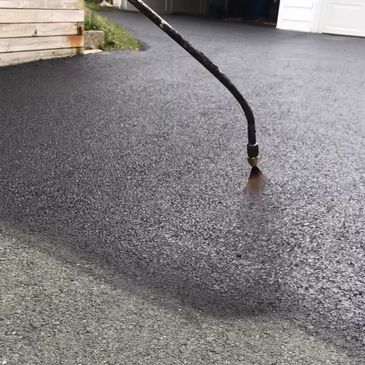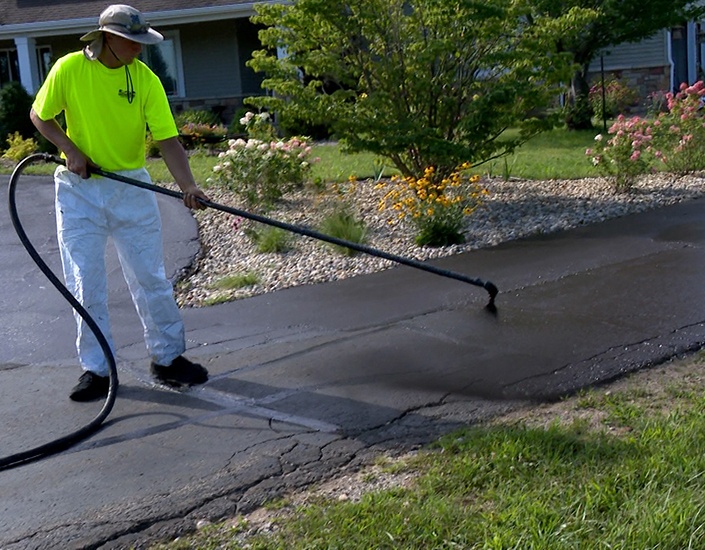Maximize Durability: Hot Mix Asphalt Sealing for Angled Parking Structures
Maximize Durability: Hot Mix Asphalt Sealing for Angled Parking Structures
Blog Article
Hot Mix Asphalt: A Sustainable Option for Sidewalk
Hot Mix Asphalt (HMA) has actually emerged as a leading lasting option for pavement options, supplying a myriad of ecological advantages and ingenious innovations. As the need for eco-friendly building and construction methods expands, exploring the nuances of HMA's sustainability can offer valuable insights right into the future of pavement solutions.
Environmental Benefits of Warm Mix Asphalt

Moreover, Hot Mix Asphalt aids to alleviate city heat island effects. Its dark color soaks up sunlight, minimizing the amount of warmth mirrored back right into the atmosphere contrasted to lighter-colored sidewalks. This can decrease ambient temperature levels in metropolitan areas, lowering the demand for a/c and eventually lowering power usage.
Furthermore, Hot Mix Asphalt adds to enhanced stormwater administration. Its permeable nature allows water to charge and infiltrate the pavement groundwater products, minimizing runoff and the risk of flooding. These ecological advantages make Warm Mix Asphalt a lasting option for paving highways and roadways.
Energy Effectiveness in HMA Production
Is power performance an essential consider the production of Warm Mix Asphalt (HMA)? Definitely. Energy plays a substantial duty in the production of HMA, impacting both cost and environmental sustainability. One crucial aspect of power efficiency in HMA production is making use of warm mix asphalt (WMA) technologies (commercial parking lot paving). WMA permits for the blending and placement of asphalt at lower temperatures contrasted to standard hot mix asphalt, causing decreased energy intake during production. This procedure not just lowers gas usage but additionally lowers greenhouse gas exhausts, making it a much more eco pleasant alternative.
Additionally, developments in plant modern technologies have actually resulted in even more energy-efficient HMA manufacturing processes. Modern plants are made with functions like recycled asphalt pavement (RAP) handling abilities, efficient heater systems, and improved insulation, all adding to energy financial savings. By enhancing energy usage in HMA manufacturing, the market can lower its carbon footprint while keeping top notch pavement materials. Power effectiveness is, therefore, a vital consideration in making certain the sustainability of Hot Mix Asphalt manufacturing.
Recyclability of Hot Mix Asphalt
The recyclability of Warm Mix Asphalt (HMA) is a crucial aspect of its sustainability and long-lasting ecological impact. HMA is one of the most recycled products in the USA, with over 100 million loads of recovered asphalt sidewalk (RAP) being recycled annually in new pavement building. Reusing HMA supplies numerous environmental benefits, such as reducing the requirement for virgin materials, reducing power intake throughout manufacturing, and lowering the quantity of waste sent to landfills.
The process of recycling HMA includes grating the existing pavement, crushing it into smaller pieces, and mixing it with new aggregate and asphalt binder to produce a recycled mix. This recycled mix can typically do along with or perhaps far better than standard HMA, while calling for less resources and generating lower greenhouse gas discharges. By incorporating RAP right into new pavement projects, road agencies can save all-natural sources, lower costs, and reduce the environmental impact of road building and construction and upkeep tasks. Generally, the recyclability of HMA plays a substantial duty in advertising sustainable techniques within the sidewalk sector.

Long-Term Efficiency of HMA
Asphalt sidewalks demonstrate sturdiness and durability over an extensive duration, mirroring the lasting efficiency of Warm Mix Asphalt (HMA) The long life of HMA can be credited to its capacity to hold up against hefty traffic loads, harsh weather conditions, and the effects of aging. Studies have revealed that properly designed and effectively created HMA sidewalks can last for twenty years or more with routine maintenance. The key to taking full advantage of the long-lasting performance of HMA depends on making use of high-grade products, complying with finest methods in building, and executing reliable upkeep methods. Proper drainage, regular examinations, and prompt repair work are important for preserving the structural integrity of HMA sidewalks gradually. Furthermore, advancements in HMA modern technology, such as using polymer-modified binders and warm mix asphalt, have better improved the resilience and longevity of HMA sidewalks. By prioritizing top quality building and upkeep methods, HMA continues to confirm itself as a economical and sustainable remedy for lasting sidewalk facilities.

HMA: Sturdiness and Sustainability
Demonstrating both longevity and sustainability, Hot Mix Asphalt (HMA) has come to be a cornerstone in the building and construction of resilient pavement facilities - angled parking. HMA's longevity comes from its ability to stand up to heavy tons, harsh climate conditions, and high web traffic volumes, making it a trustworthy choice for roads, highways, and flight terminal paths. The composition of HMA, which normally includes aggregates, binder, and filler, plays useful link a critical role in improving its longevity and resistance to tear and wear
Furthermore, HMA's sustainability depends on its recyclability and energy-efficient production process. The capacity to recycle redeemed asphalt pavement (RAP) in brand-new HMA combinations reduces the need for virgin products and reduces the environmental influence of sidewalk construction and maintenance. In addition, the power efficiency of creating HMA hinges on its reduced blending temperature levels compared to other pavement materials, bring about reduced energy consumption and greenhouse gas discharges.
Final Thought
To conclude, hot mix asphalt (HMA) uses a sustainable option for sidewalk with its eco-friendly attributes. HMA's recyclability, power performance in production, and long-term longevity make it an environment-friendly selection for roadway construction. By conserving discover this info here natural sources, lowering waste, and lowering greenhouse gas emissions, HMA plays an important function in advertising sustainability in facilities advancement. Its capacity to minimize city warmth island effects additionally underscores its importance in creating resilient and ecologically aware sidewalk systems.
HMA is one of the most recycled products in the United States, with over 100 million tons of recovered asphalt sidewalk (RAP) being recycled every year in new pavement building.The procedure of reusing HMA involves crushing the existing pavement, squashing it into smaller sized pieces, and blending it with new accumulation and asphalt binder to produce a recycled mix.Asphalt pavements show sturdiness and resilience over a prolonged period, showing the lasting performance of Warm Mix Asphalt (HMA) Additionally, innovations in HMA innovation, such look at this website as the usage of polymer-modified binders and warm mix asphalt, have actually further improved the resilience and long life of HMA pavements. The capability to recycle reclaimed asphalt sidewalk (RAP) in brand-new HMA mixes lowers the demand for virgin products and minimizes the environmental influence of pavement building and upkeep.
Report this page